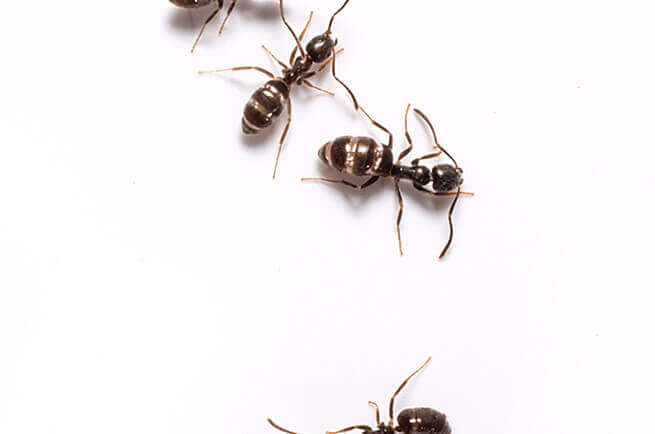What Do Odorous House Ants Look Like?

Adult odorous house ants are small, even for ants, at about one-eighth inch long. That’s around the size of a sesame seed. The pests are dark brown to black and have uneven thoraxes. During mating seasons, colonies will produce flying reproductives. These insects look like workers except for their two pairs of wings.
How Can I Tell if I Have an Odorous House Ant Problem?
Seeing a couple of ants crawling across the floor might not point to an infestation. One or two pests can wander into homes and commercial spaces searching for a meal or come inside by mistake on clothing. Signs of a more serious odorous house ant issue include:
- Nests – Odorous house ants nest near a food supply, often relocating or creating new colonies indoors.
- Trails – Once the pests come across a meal, they leave pheromone trails behind for others to follow. As a result, you may see long lines of ants moving quickly to and from cupboards.
- Flying ants – Winged reproductives flying in windows or around light fixtures indicate a mature colony on or near your property. Swarms of winged ants inside can suggest that the nest is indoors.
- Odor – When crushed, an odorous house ant creates a foul smell similar to an overripe banana or rotten coconut. Noticing this scent in your home indicates an ant problem.
How Do Odorous House Ants Get Inside Homes and Businesses?
Odorous house ants set up many nests to find food sources, sometimes moving a colony every three to four weeks. Due to their small size, the ants can squeeze through tiny foundation cracks or gaps around doors and windows. If you’ve had trouble with termites, the ants may also take shelter in old insect tunnels.
Indoors, odorous house ants favor moist places. Water-damaged wood near bathroom plumbing and kitchen sinks is a prime target. Businesses handling large volumes of water might struggle to avoid these pests. Colonies often infest floors under restaurant dishwashers and hotel laundry rooms. Tenants who don’t report leaky pipes may lead to ant problems for apartment managers.
Are Odorous House Ants Dangerous?
Since the pests rarely bite, contaminated food is the main issue related to infestation. While odorous house ants aren’t known to carry diseases, finding them in food is unpleasant. The insects also gather in great numbers, so they can get into a large amount of goods.
As odorous house ants prefer sweets, they can devastate profits for bakeries and food processing plants. These pests may even crawl into poorly sealed grocery store products and pantry goods like sugar, honey, and meat.
How Can I Prevent Odorous House Ant Infestations?
Odorous house ants are one of the most common pest ants in New England, so keeping up with prevention is key. After meals, wash dishes, cover leftovers, and wipe down counters. Sweep and mop regularly to remove crumbs or spills that might attract them. Moving woodpiles away from walls and sealing holes around vents or wires can also deter entry.
For expert advice on odorous house ant removal, contact Waltham Pest Services. Skilled technicians can control stubborn ant infestations and help to stop them from returning.